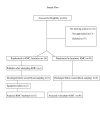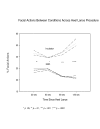Kangaroo mother care diminishes pain from heel lance in very preterm neonates: a crossover trial
- PMID: 18435837
- PMCID: PMC2383886
- DOI: 10.1186/1471-2431-8-13
Kangaroo mother care diminishes pain from heel lance in very preterm neonates: a crossover trial
Abstract
Background: Skin-to-skin contact, or kangaroo mother care (KMC) has been shown to be efficacious in diminishing pain response to heel lance in full term and moderately preterm neonates. The purpose of this study was to determine if KMC would also be efficacious in very preterm neonates.
Methods: Preterm neonates (n = 61) between 28 0/7 and 31 6/7 weeks gestational age in three Level III NICU's in Canada comprised the sample. A single-blind randomized crossover design was employed. In the experimental condition, the infant was held in KMC for 15 minutes prior to and throughout heel lance procedure. In the control condition, the infant was in prone position swaddled in a blanket in the incubator. The primary outcome was the Premature Infant Pain Profile (PIPP), which is comprised of three facial actions, maximum heart rate, minimum oxygen saturation levels from baseline in 30-second blocks from heel lance. The secondary outcome was time to recover, defined as heart rate return to baseline. Continuous video, heart rate and oxygen saturation monitoring were recorded with event markers during the procedure and were subsequently analyzed. Repeated measures analysis-of-variance was employed to generate results.
Results: PIPP scores at 90 seconds post lance were significantly lower in the KMC condition (8.871 (95%CI 7.852-9.889) versus 10.677 (95%CI 9.563-11.792) p < .001) and non-significant mean differences ranging from 1.2 to1.8. favoring KMC condition at 30, 60 and 120 seconds. Time to recovery was significantly shorter, by a minute(123 seconds (95%CI 103-142) versus 193 seconds (95%CI 158-227). Facial actions were highly significantly lower across all points in time reaching a two-fold difference by 120 seconds post-lance and heart rate was significantly lower across the first 90 seconds in the KMC condition.
Conclusion: Very preterm neonates appear to have endogenous mechanisms elicited through skin-to-skin maternal contact that decrease pain response, but not as powerfully as in older preterm neonates. The shorter recovery time in KMC is clinically important in helping maintain homeostasis.
Trial registration: (Current Controlled Trials) ISRCTN63551708.
Figures
References
-
- Simons SH, van Dijk M, Anand KS, Roofthooft D, van Lingen RA, Tibboel D. Do we still hurt newborn babies? A prospective study of procedural pain and analgesia in neonates. Archives of Pediatrics & Adolescent Medicine 157(11):1058-64, 2003. - PubMed
-
- Stevens B, Johnston C, Taddio A, Jack A, Narciso J, Stremler R, Koren G, Aranda J. Management of pain from heel lance with lidocaine-prilocaine (EMLA) cream: is it safe and efficacious in preterm infants? Journal of Developmental & Behavioral Pediatrics. 1999;20:216–221. doi: 10.1097/00004703-199908000-00002. - DOI - PubMed
-
- Larsson BA, Norman M, Bjerring P, Egekvist H, Lagercrantz H, Olsson GL. Regional variations in skin perfusion and skin thickness may contribute to varying efficacy of topical, local anaesthetics in neonates. Paediatric Anaesthesia. 1996;6:107–110. doi: 10.1111/j.1460-9592.1996.tb00370.x. - DOI - PubMed






